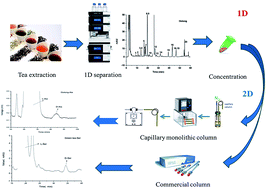Separation and detection of free d- and l-amino acids in tea by off-line two-dimensional liquid chromatography†
Abstract
D-amino acids are currently paid attention to as new physiologically active substances. Foodstuffs and beverages containing D-amino acids are a matter of interest. Until now, the profiles of D-amino acids have not been reported in natural and fermented teas except theanine. In this study, an off-line 2D-HPLC method combining a Gemini C18 column and a CHIRALPAK® IC-3 column or a self-prepared poly(MQD-co-HEMA-co-EDMA) monolithic capillary column was employed for the separation and detection of D-amino acids in tea samples with the co-existence of a large amount of L-amino acids. The free amino acid fractions in longjing, black, oolong, and pu-erh tea samples were separated and collected after pre-column derivatization using 9-fluorenylmethoxycarbonyl (FMOC) chloride in the reversed-phase mode, and then were concentrated and separated to D- and L-forms on a chiral column. Among them, the D-form of isoleucine (Ile) (1.0–1.6%), alanine (Ala) (0.1–0.8%), phenylalanine (Phe) (0.1–0.4%), valine (Val) (0.2–0.3%), serine (Ser) (0.1–0.2%), aspartic acid (Asp) (0.2%), and proline (Pro) (0.1%) were detected in longjing and oolong teas. Differences between natural tea and fermented tea in the profiles of D-amino acids as well as the total amino acids were also observed. The results provided useful information for the bio-function research of D-amino acids in tea.



 Please wait while we load your content...
Please wait while we load your content...